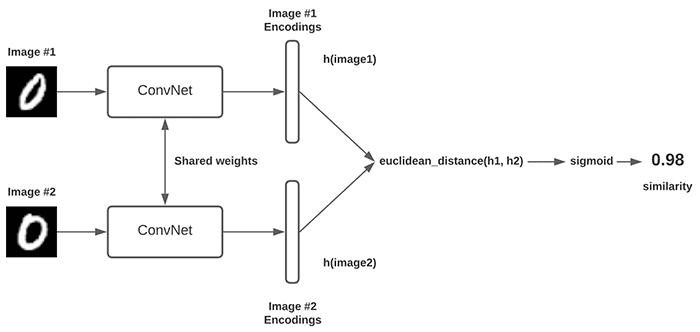Siamese Neural Network(SNN)
Exploring Siamese Neural Networks: Understanding the Architecture and Applications
In recent years, deep learning has revolutionized the field of machine learning, and one of the most significant advancements has been the development of Siamese neural networks. Siamese neural networks are neural networks used for various tasks such as image recognition, face verification, and text analysis. This blog post will explore the basics of Siamese neural networks and how they work.
What is a Siamese Neural Network?
A Siamese neural network is a type of neural network architecture that is used for measuring the similarity between two inputs. The term "Siamese" refers to the fact that the network is composed of two identical subnetworks, which are called "twins." The twin networks share the same weights and architecture, which means that they learn the same features from the input data.
The main goal of a Siamese neural network is to learn a similarity function that can determine how similar or dissimilar two inputs are. For example, in image recognition tasks, the network can learn to recognize whether two images contain the same object or not. In text analysis, the network can learn to identify whether two sentences convey the same meaning or not.
The Architecture of Siamese Neural Network

The architecture of a Siamese neural network consists of two identical subnetworks, known as "twins," that share the same weights and architecture. The input data is fed into each twin network, and each network learns to map the input to a low-dimensional feature vector. These feature vectors are then compared using a distance metric, such as Euclidean distance or cosine similarity, to determine the similarity between the two inputs. The network is trained using pairs of inputs, along with labels that indicate whether the inputs are similar or dissimilar, to learn the optimal weights and biases that minimize the distance for similar inputs and maximize the distance for dissimilar inputs.
Siamese Neural Network work?
A Siamese neural network works by processing two inputs through identical subnetworks and then comparing the output vectors produced by these subnetworks. The network learns to map each input to a low-dimensional vector, which represents the features of that input. These feature vectors are then compared using a distance metric such as Euclidean distance or cosine similarity.
During training, the network is provided with pairs of inputs, along with a label that indicates whether these inputs are similar or dissimilar. The network learns to adjust its weights and biases to minimize the distance between feature vectors for similar inputs and maximize the distance for dissimilar inputs.
Implementation of Simple Siamese Neural Network
Here's a simple implementation of a Siamese neural network in Python using the Keras library:
from keras.models import Sequential, Model
from keras.layers import Input, Dense, Dropout, Lambda
def build_siamese_network(input_shape):
model = Sequential()
model.add(Dense(128, activation='relu', input_shape=input_shape))
model.add(Dropout(0.1))
model.add(Dense(64, activation='relu'))
model.add(Dropout(0.1))
model.add(Dense(32, activation='relu'))
model.add(Dense(16, activation='relu'))
return model
input_shape = (784,) # input shape for MNIST dataset
# define the left and right input layers
left_input = Input(input_shape)
right_input = Input(input_shape)
# build the siamese network
siamese_network = build_siamese_network(input_shape)
# encode the left and right inputs using the siamese network
left_encoded = siamese_network(left_input)
right_encoded = siamese_network(right_input)
# compute the Euclidean distance between the left and right encoded vectors
distance = Lambda(lambda x: K.sqrt(K.sum(K.square(x[0] - x[1]), axis=-1)))([left_encoded, right_encoded])
# define the full siamese model with both input and distance output
siamese_model = Model(inputs=[left_input, right_input], outputs=distance)
Explanation: We first define a function build_siamese_network that builds the shared subnetwork that will be used for both the left and right inputs. We then define the left and right input layers using Input and encode them using the siamese network using siamese_network(left_input) and siamese_network(right_input). Finally, we compute the Euclidean distance between the encoded vectors using Lambda and define the full siamese model using Model.
Siamese neural networks can be used for a variety of tasks, including:
Image recognition: Siamese neural networks can learn to recognize whether two images contain the same object or not. This is useful for tasks such as facial recognition and object recognition.
Text analysis: Siamese neural networks can learn to identify whether two sentences convey the same meaning or not. This is useful for tasks such as natural language processing and text classification.
Signature verification: Siamese neural networks can learn to recognize whether two signatures are from the same person or not. This is useful for tasks such as document verification and fraud detection.
Advantages of Siamese Neural Networks
Reduced number of parameters: Since Siamese neural networks use identical subnetworks, they have fewer parameters than other neural network architectures. This makes them more computationally efficient and easier to train.
Robust to noise: Siamese neural networks are more robust to noisy data than other neural network architectures. This is because they learn to focus on the features that are most important for similarity comparison, rather than trying to fit the noise in the data.
Transfer learning: Siamese neural networks can be used for transfer learning, where the pre-trained weights of the subnetworks are used to initialize the weights of a new network. This allows for faster training and better performance on smaller datasets.
Conclusion
Siamese neural networks are a powerful tool for measuring the similarity between two inputs. They have been successfully applied to various tasks, including image recognition, text analysis, and signature verification. Siamese neural networks have several advantages over other neural network architectures, including a reduced number of parameters, robustness to noise, and transfer learning capabilities. If you are interested in learning more about Siamese neural networks, there are several online resources available that provide more detailed information and examples of their applications.
